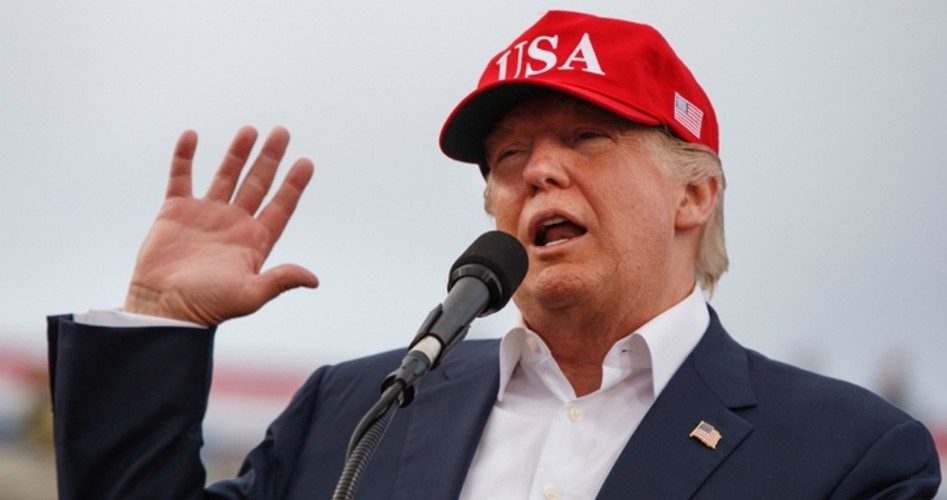
Despite a concerted effort, mostly by disgruntled Democrats, to overturn the results of the November 8 presidential election, New York businessman Donald J. Trump was nevertheless chosen by the Electoral College on Monday as the nation’s 45th president. The final results gave Republican Trump 304 electoral votes to 227 for Democrat Hillary Clinton. Electors also cast votes for former Secretary of State Colin Powell, former Texas Congressman Ron Paul, Ohio Governor John Kasich, Native American tribal leader Faith Spotted Eagle, and Vermont’s Senator Bernie Sanders.
Trump’s surprise win in November resulted in a frenzied effort by Clinton supporters to deny him the presidency. Ironically, before the election, Clinton had demanded that Trump publicly agree to accept the results of the election; however, after the election, Clinton herself wouldn’t accept the results, never disavowing the long-shot attempt to get enough electors to switch their votes to put her in the White House.
Presidential electors are chosen through a legal process created by each state’s legislature, and almost all the states presently award their electoral votes to the person who finishes first in the state’s popular vote. The only two exceptions are Nebraska and Maine, each of which gives an electoral vote to the candidate who carries a congressional district within their state, although two votes in each of the two states go to the person who runs first, statewide.
Trump’s opposition needed 37 Republican electors to break ranks in order to drop his total below 270. With 538 total members of the Electoral College, 270 is the minimum number required to get a majority of the electoral vote. The Constitution requires that a candidate must obtain a majority of the electoral vote to win the election — otherwise the election is decided in the House of Representatives. If neither Trump nor Clinton had won the electoral vote, it is almost certain that a Republican (likewise almost certainly Trump) would have been elected, since Republicans hold a majority of the state delegations in the House by a comfortable margin.
In the end, only two Republican electors defected, both from Texas. There, one elector cast his ballot for Ohio Governor John Kasich (another Republican candidate for his party’s nomination this year) while the other opted to vote for former Texas Congressman Ron Paul, who sought the Republican nomination in 2008 and 2012. Paul’s son Senator Rand Paul (R-Ky.) made his own bid for the Republican nomination this year.
Outside the Texas state capitol in Austin, about 100 protesters held signs that read, “Save our democracy.”
What was perhaps most surprising was that more Democrat electors abandoned their nominee — Hillary Clinton — than Republicans who defected from Trump. Although Colin Powell served a Republican president (George W. Bush) as secretary of state, and had been in two other Republican administrations, he picked up three electoral votes from Democrat electors in Washington State. Another Washington State elector decided to vote for Faith Spotted Eagle, a Native American tribal elder from South Dakota who led opposition to the Keystone XL pipeline.
One elector in Hawaii voted for Clinton’s primary opponent, Senator Bernie Sanders.
In 1976, a Washington State Republican elector voted for Ronald Reagan rather than President Gerald Ford. The last time a “faithless elector” had crossed party lines was in 1972, when a Republican elector opted to vote for the Libertarian Party nominee rather than Republican nominee Richard Nixon.
Some Republican electors faced serious intimidation and threats before they cast their votes. In Pennsylvania, where Trump became the first Republican to carry the state since 1988, elector Ash Khare stated that he and each of the other 19 electors were assigned a plainclothes state police trooper for protection.
Protesters shouted from the gallery of the Pennsylvania legislative chamber, “Shame on you!” Outside, more than 200 demonstrators shivered in freezing temperatures, chanting, “No Trump, no KKK, no fascist USA!” Others chanted, “No treason, no Trump!”
Beth Pulcinella, an art teacher from Philadelphia, organized a 24-hour vigil outside the Pennsylvania Capitol. “This is a moment,” she said, “where there’s this decision that can be made and we could really change history in the specific way that we really feel like would benefit everybody profoundly.”
“I take my job as an elector very seriously, and in Pennsylvania, Donald Trump won,” declared Mary Barket, who serves as president of the Pennsylvania Federation of Republican Women. (This is typical of electors, who are usually party stalwarts.) “So, any argument thereafter, especially about the nature of him being a president, is not going to have an effect on me.”
Over the past month, Barket received numerous phone calls, e-mails, and letters urging her to abandon Trump. Some suggested she read the Federalist Papers, since one of its three authors, Alexander Hamilton, warned in Federalist, No. 68 that there may be “the desire in foreign powers to gain an improper ascendant in our councils.” Hamilton argued that the Electoral College could serve as a fail-safe to keep any such candidate controlled by a foreign power from becoming president. Those attempting to persuade Republican electors to defect from Trump argued that Trump might be beholden to Russian President Vladimir Putin, since they believed that the Russian government had hacked Clinton’s e-mails and gave them to WikiLeaks, supposedly causing her defeat.
Christine Pelosi, daughter of House Democrat Leader Nancy Pelosi, even urged that electors be given a classified briefing from James Clapper, director of National Intelligence, about Russia’s supposed hacking as it related to the U.S. presidential election.
“I’m a big boy,” Pennsylvania elector Khare declared. “But this is stupid. Nobody is standing up and telling these people, ‘Enough, knock it off.’” Khare even received a letter from a seven-year-old boy, who told him that he was scared about Trump becoming president. One woman let him know that her husband was out of the country. Another person woke him up at 1:00 a.m. to plead with him to switch from Trump.
But Khare concluded, “I will not change my mind.”
Similar sentiments were expressed by Robert Graham, an elector in Arizona who serves as the state Republican Party chairman. He said President Barack Obama and Democrat nominee Hillary Clinton should “tell people trying to intimidate Electoral College voters to stand down.” Graham said he received e-mails from individuals telling him that they knew where he lived, and he was then followed two days in a row on the freeway by someone with a phone videotaping him.
Republican electors in every state reported receiving “encouragement” to switch their votes, and liberal “documentary” filmmaker Michael Moore even offered to pay the fines for electors who would violate state law to make the switch to Hillary.
However, most states’ voting was largely uneventful. In New York State, former President Bill Clinton was one of that state’s presidential electors. Not surprisingly, he voted for his wife, saying he “never cast a vote I was prouder of.” He added that he believed Hillary would have won nationally if not for the alleged Russian hacking, and the announcement of the FBI that they were reviewing new e-mails they had found from the time Clinton was secretary of state under Obama.
On the other hand, in Mississippi, Republican elector Charles Evers, a former GOP mayor of Fayette and a talk-radio host, cast his vote for Trump. His brother, Medger Evers, was an anti-segregation activist murdered in 1963.
Ryan Clayton, leader of Americans Take Action (against Trump), admitted defeat in his effort to get the electors to stop Trump, and explained why he thought the effort had failed: “When they [the Republican electors who were considering defecting from Trump] saw the trend line [of most of the possible defectors voting for Trump anyway], they just decided to get out of the way of the electoral Alamo that was taking place.”
Photo: AP Images

